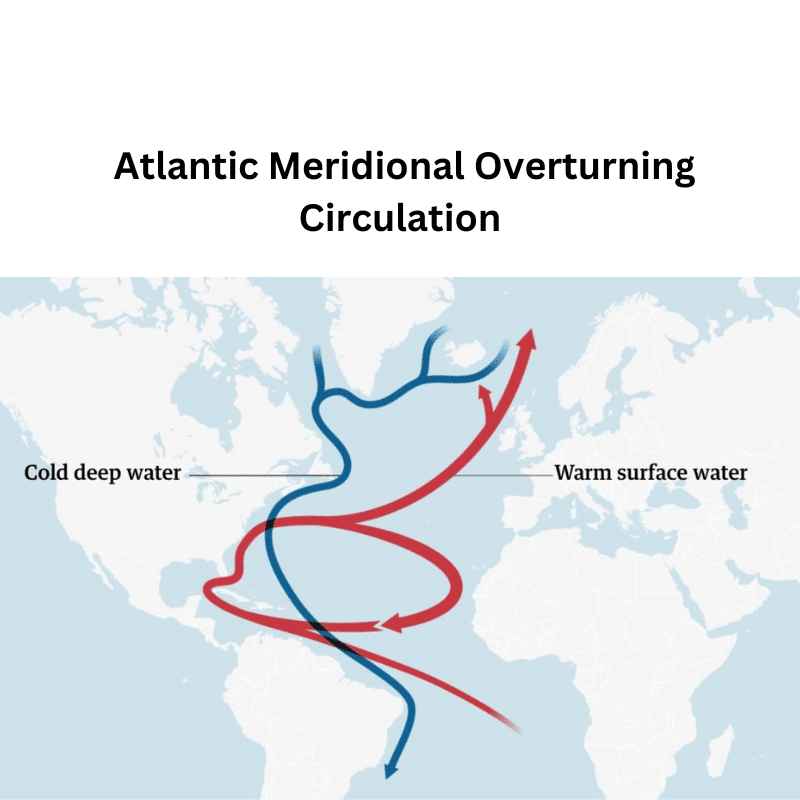
The extensive, interconnected network of water currents in the oceans is known as ocean circulation.
It includes both surface and deep currents.
Atlantic meridional overturning circulation (AMOC) is one such example of ocean circulation.
What is Atlantic Meridional Overturning Circulation (AMOC)?
The Atlantic Meridional Overturning Circulation (AMOC) is a major ocean current system that transports warm surface waters from the tropics toward the northern Atlantic and colder deep waters that are part of the thermohaline circulation, southward. One of the main ways the ocean circulates heat, salt, carbon, and nutrients throughout the world’s oceans is through overturning circulation.
Now you might be wondering what is thermohaline circulation. Let us quickly look into it and come back to AMOC.
What is thermohaline circulation?
The thermohaline circulation, also known as the ocean’s conveyor belt, is part of the ocean circulation and is powered by temperature and salinity differences causing density differences. These are deep ocean currents occurring thousands of meters below the sea surface.
It leads to intermixing of salt and heat. Thus, it effectively describes a driving mechanism.
Now let us come back to Atlantic meridional overturning circulation. We shall discuss in detail the working of AMOC.
Working of Atlantic Meridional Overturning Circulation
- The Atlantic Ocean’s warm water cools as it travels north, and evaporation raises its salt content.
- The water sinks deep into the ocean due to its increased density brought on by a combination of a low temperature and a high salt content.
- Deep below, the chilly, dense water steadily moves southward.
- It eventually returns to the surface, warms up once more, and the circulation is complete.

Significance of AMOC
- AMOC helps to disperse heat and energy throughout the earth (heat budget).
- Because of AMOC, the climate in Western Europe is less severe even during the winter (Gulf Stream, North Atlantic Drift).
- By absorbing and storing carbon from the atmosphere, it serves as a carbon sink.
- Carbon sequestration by AMOC has profound effects on how anthropogenic global warming develops.
- The distribution of heat to the polar regions is largely dependent on thermohaline circulation. As a result, it impacts how quickly sea ice forms at the poles, which in turn affects other components of the climate system (such as the albedo, and thus solar heating, at high latitudes)
Is the AMOC slowing down?
According to the IPCC’s Report (AR6), it is very likely that AMOC will decline over the 21st century.
This is due to the fact that as the atmosphere heats, the surface ocean below it holds onto more heat. Meanwhile, the ocean gets fresher due to increases in rainfall and ice melt. All of these modifications lighten the ocean water, which lessens the sinking in the “conveyor belt”.
This results in a weaker AMOC. The AMOC will therefore most certainly diminish. But it is quite improbable that it would undergo the kind of huge, abrupt shifts in the 21st century as have been observed in the past.
Consequences of a slowing AMOC?
Slowing down of the AMOC would have the following consequences:
- Further decline in marine productivity in the North Atlantic (less sinking will result in less mixing of water)
- An increase in regional sea level along the northeast coast of North America
- More storms in Northern Europe
- A decrease in Sahelian summer rainfall
- Decrease in South Asian summer rainfall.
Impact of the Indian Ocean
One of the footprints of global warming is the Indian Ocean. The Indian Ocean produces more precipitation as it warms up more quickly. More air, particularly air from the Atlantic, is drawn to the Indian Ocean as a result.
There will be less precipitation in the Atlantic Ocean due to the Indian Ocean receiving so much precipitation. Higher salinity in the tropical Atlantic Ocean waters will result from less precipitation.
As it travels north through the AMOC, this saltier water will cool considerably more quickly than usual and sink more quickly. However, it’s unclear how long the Indian Ocean’s increased heat will last, according to scientists.
The advantage for AMOC will end if warming in other tropical oceans, particularly the Pacific, catches up with that in the Indian Ocean.
Article written by: Caroline Abraham






Leave a Reply